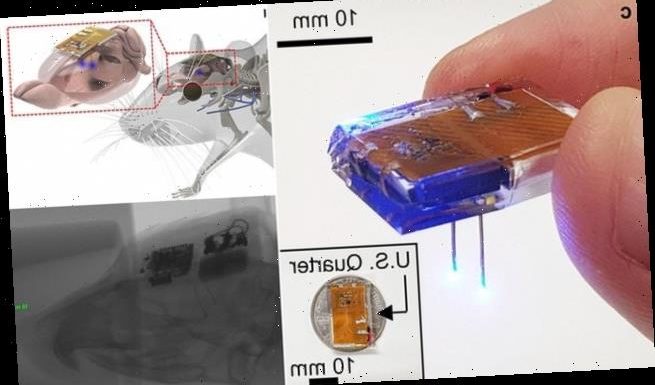
Smartphone-controlled brain implant the size of a PENNY combats drug addiction in rats – and it could be used to treat Parkinson’s disease and depression in humans
- Korean researchers made the gadget which is roughly as long as a US penny
- Tiny LED lights manipulate neurons in the brain as instructed by a phone app
- Circuit in the device has an antenna and Bluetooth chip that charges wirelessly
- Researchers believe the chips could be used to treat a range of neurological conditions in humans, including Parkinson’s and depression
Brain implants controlled by a mobile phone and recharged wirelessly via Bluetooth could help cure addiction, Parkinson’s and depression.
The device, roughly the length of a US penny, controls brain function for long periods without the need for regular invasive procedures to change the batteries.
LEDs built into the device are the size of a grain of salt and use light to manipulate neurons in the brain.
Tests in rats found it suppresses drug addiction and researchers hope it could also be used in humans to treat neurological conditions.
Scroll down for video
The device, roughly the length of a US penny, controls brain function for long periods without the need for regular invasive procedures to change the batteries
A smartphone connects to the implant wirelessly and builds on the success of previous models which were mounted to the head.
‘This powerful device eliminates the need for additional painful surgeries to replace an exhausted battery in the implant, allowing seamless chronic neuromodulation,’ said Professor Jae-Woong Jeong, lead author of the study from The Korea Advanced Institute of Science and Technology (KAIST).
‘We believe that the same basic technology can be applied to various types of implants, including deep brain stimulators, and cardiac and gastric pacemakers, to reduce the burden on patients for long-term use within the body.’
‘Wireless battery re-charging makes experimental procedures much less complicated,’ said the co-lead author Min Jeong Ku, a researcher at Yonsei University’s College of Medicine.
One of the many layers of the brain implant is a small circuit which combines an antenna with an energy harvester as well as a Bluetooth chip.
This converts harmless waves of alternating magnetic current into charge for the battery.
A smartphone app then allows customisation of the neuron-controlling LEDs.
‘This device can be operated anywhere and anytime to manipulate neural circuits, which makes it a highly versatile tool for investigating brain functions,’ said lead author Choong Yeon Kim.
Trials of the technology involved implanting the gadget into the brains of rats, injecting the rats with cocaine and ten activating the chip to see if it could suppress addiction to the drug.
‘The fact that we can control a specific behaviour of animals, by delivering light stimulation into the brain just with a simple manipulation of smartphone app, watching freely moving animals nearby, is very interesting and stimulates a lot of imagination,’ said Jeong-Hoon Kim, a professor of physiology at Yonsei University’s College of Medicine.
The research has been published in Nature Communications.
WHAT IS PARKINSON’S? THE INCURABLE DISEASE THAT STRUCK BOXER MUHAMMAD ALI
Parkinson’s disease affects one in 500 people, and around 127,000 people in the UK live with the condition.
Figures also suggest one million Americans also suffer.
It causes muscle stiffness, slowness of movement, tremors, sleep disturbance, chronic fatigue, an impaired quality of life and can lead to severe disability.
It is a progressive neurological condition that destroys cells in the part of the brain that controls movement.
Sufferers are known to have diminished supplies of dopamine because nerve cells that make it have died.
There is currently no cure and no way of stopping the progression of the disease, but hundreds of scientific trials are underway to try and change that.
The disease claimed the life of boxing legend Muhammad Ali in 2016.
Source: Read Full Article
